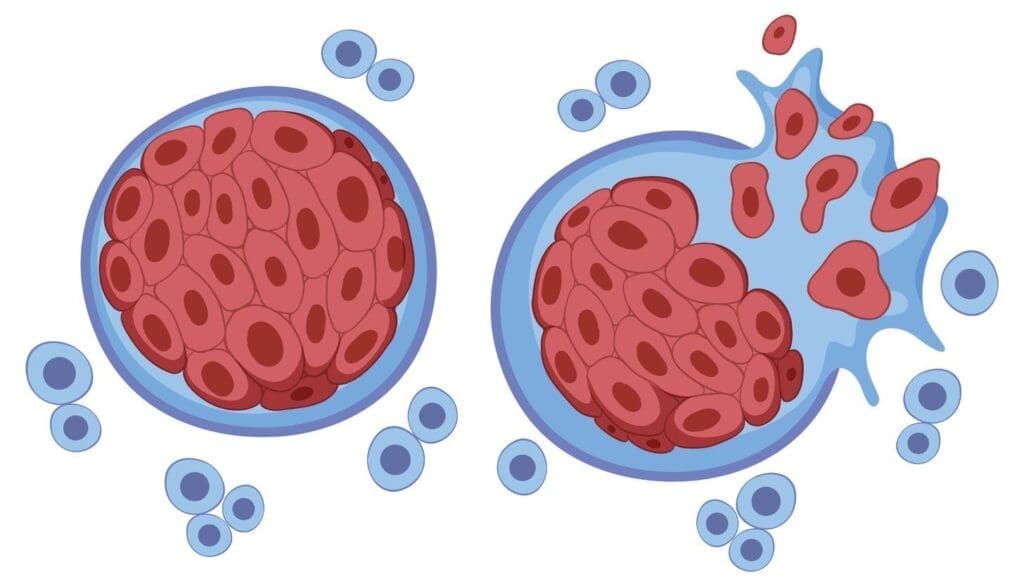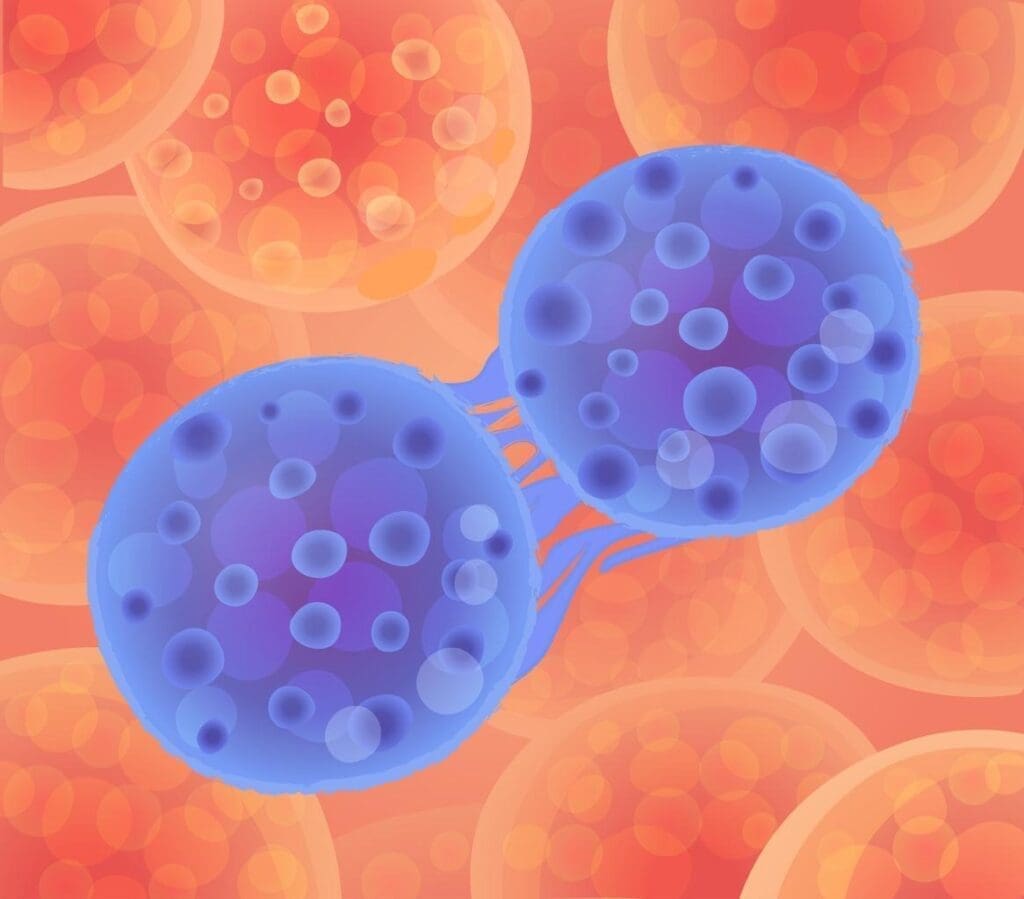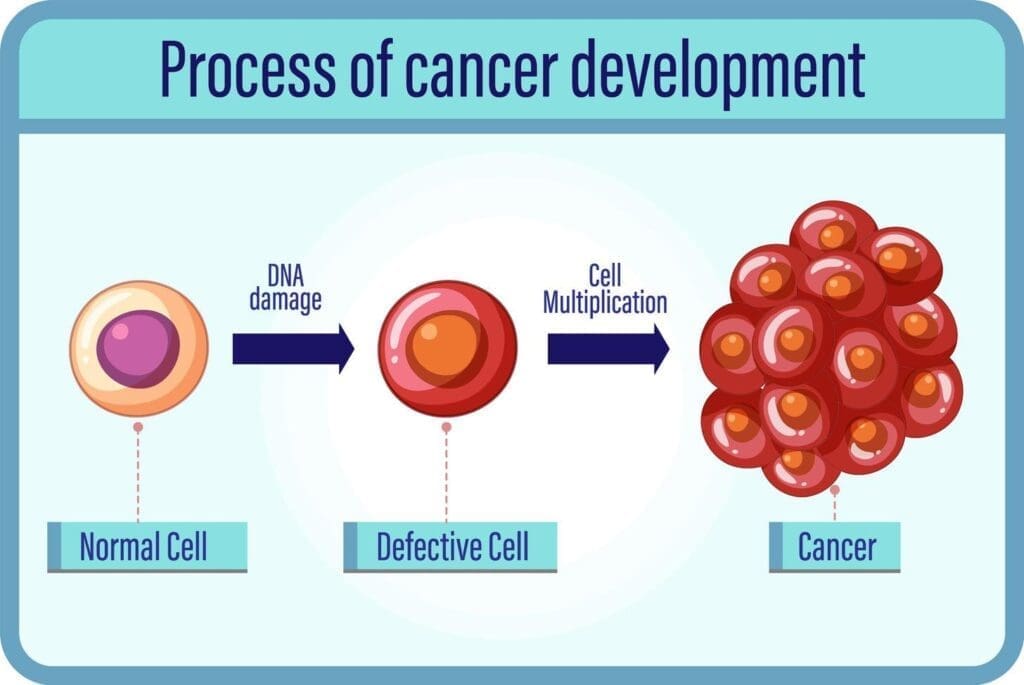Last Updated on November 14, 2025 by Ugurkan Demir

At Liv Hospital, we know that the thought of having a tumor can be scary. Not all tumors are cancerous. It’s important to know when a benign tumor might turn malignant to make good health choices.
A benign tumor is a growth of abnormal, noncancerous tissue that grows slowly. It stays in one place and doesn’t spread to nearby areas. On the other hand, a malignant tumor has cancerous cells. These cells can grow fast, spread to other areas, and even go to distant organs.
We will look at the big differences between benign and malignant tumors. We’ll also talk about when a benign tumor might turn malignant. Knowing how tumors form and what they look like is key for catching them early and treating them right.

It’s key to know the difference between benign and malignant tumors. This helps both patients and doctors deal with tumor diagnosis and treatment. Tumors are abnormal cell growths. They can be benign, or non-cancerous, or malignant, or cancerous.
We’ll look at what makes each type special. This will help us understand their health effects and treatment choices.
Benign tumors are non-cancerous growths that don’t spread. They grow slowly and have clear edges.
Even though benign tumors are usually safe, they can be a problem. If they get too big, they can press on nerves, organs, or blood vessels. For example, a brain tumor can cause brain symptoms because of the pressure.
Malignant tumors, or cancerous tumors, can spread. They grow fast and have irregular shapes.
Malignant tumors are a big health risk. They need quick and strong treatment to stop them from spreading. Knowing about malignant tumors is key for good treatment plans.
| Characteristics | Benign Tumors | Malignant Tumors |
| Growth Rate | Slow | Rapid |
| Borders | Well-defined | Irregular |
| Invasion and Metastasis | No invasion or metastasis | Can invade and metastasize |
| Cancerous | No | Yes |

Tumors form through a complex mix of cell changes and growth patterns. They happen when cells grow out of control, often due to genetic mutations or environmental factors. Knowing how these changes occur helps us understand tumor growth.
At the core of tumor development are cell changes. These can include genetic mutations that mess with cell signals, causing cells to grow and divide without control. Genetic mutations can come from our genes or from the environment or DNA errors.
Some key changes include:
Tumors grow in different ways, from slow-growing benign ones to fast-growing malignant ones. Their growth depends on their cell traits, like how well they invade tissues and spread to other places.
Here’s a look at benign and malignant tumor traits:
| Characteristics | Benign Tumors | Malignant Tumors |
| Growth Rate | Slow | Rapid |
| Tissue Invasion | Non-invasive | Invasive |
| Metastasis | No | Yes |
Grasping tumor biology is key for better diagnosis and treatment. By spotting the differences between benign and malignant tumors, doctors can offer the right care and options for patients.
We look into if benign tumors can turn into cancer. Not all benign tumors become cancerous. But, some types can change into cancer through a process called malignant transformation.
The change from benign to malignant involves complex genetic and environmental changes. Genetic mutations are key in this process. They let tumor cells spread and grow in other parts of the body.
This change doesn’t happen right away. It takes time, with many steps and changes in the tumor cells. For example, some colon polyps can turn into colorectal cancer if not treated. This shows how benign tumors can sometimes become cancerous.
The chance of a benign tumor turning into cancer varies. Some benign tumors are more likely to become cancerous than others. For example, some colon polyps have a higher risk of turning into colorectal cancer.
| Type of Benign Tumor | Risk of Malignant Transformation | Examples |
| Colon Polyps | Moderate to High | Adenomatous polyps |
| Uterine Fibroids | Low | Leiomyomas |
| Skin Lesions | Variable | Dysplastic nevi |
Knowing the risks and how tumors can change is important. Early detection and treatment can make a big difference. Regular check-ups and the right medical care can help those with benign tumors that might become cancerous.
The change from a benign tumor to a malignant one is complex. It involves many biological changes. We will look into the genetic mutations and cellular mechanisms that cause this change. This will give us insights into how cancer develops.
Genetic mutations are key in turning benign tumors into malignant ones. These mutations can happen due to environmental factors or DNA replication errors. We will see how these mutations cause cells to grow uncontrollably and become cancerous.
Key genetic mutations involved in malignant transformation include:
These genetic changes disrupt normal cell control. This leads to the development of cancerous traits.
The process of becoming malignant involves many cellular changes. We will talk about how changes in cell signaling, increased blood vessel formation, and avoiding cell death contribute to malignancy.
The process of malignant transformation is characterized by:
Cancer development is a complex process. It involves the buildup of genetic and epigenetic changes. We will explain the stages of this process, from the start to the progression. We will also discuss what affects how fast tumors grow.
The following table summarizes the key stages and characteristics of the multistep process of cancer development:
| Stage | Characteristics | Genetic/Epigenetic Changes |
| Initiation | First genetic mutation occurs | Mutation in a critical gene |
| Promotion | Clonal expansion of mutated cells | Epigenetic changes, additional mutations |
| Progression | Increased malignancy, invasion, and metastasis | Accumulation of multiple genetic mutations |
Malignancy means a tumor can invade and harm nearby tissues. This is a key sign of a malignant tumor. Metastasis, on the other hand, is when cancer cells spread to other parts of the body, creating new tumors.
A tumor is malignant if it grows out of control, invades nearby tissues, and can damage them. Malignant tumors grow fast, have irregular shapes, and can spread to other areas. We’ll look at these traits in more detail.
Malignant Tumor Characteristics| Characteristic | Description |
| Uncontrolled Growth | Malignant tumors grow quickly and without control. |
| Local Invasion | They spread to nearby tissues and organs. |
| Tissue Damage | This spreading can harm the affected area a lot. |
The table shows how malignant tumors are different and can be harmful.
Metastasis is when cancer cells from the main tumor spread to other parts of the body. This happens through the blood or lymphatic system. The steps include breaking away from the main tumor, entering the blood or lymph, surviving there, and starting new tumors in other tissues.
The metastasis process is complex, with many steps. Each step offers chances to stop cancer from spreading.Steps Involved in Metastasis1. Detachment of cancer cells from the primary tumor.
2. Invasion into the bloodstream or lymphatic system.
3. Survival of cancer cells within the system.
4. Colonization of new tissues to form secondary tumors.
It’s important to know the difference between malignancy and metastasis for effective cancer treatment. By understanding malignant tumor traits and how metastasis works, we can tackle cancer more effectively.
Many benign tumors are harmless, but some can turn into cancer. It’s important to know which ones have this risk. We’ll look at colon polyps, uterine fibroids, and skin lesions, and their chance of becoming cancerous.
Colon polyps grow on the colon or rectum’s inner lining. Most are not harmful, but some, like adenomatous polyps, can turn into colorectal cancer. The risk depends on the polyp’s type, size, and number.
It’s vital to get regular screenings to catch and remove polyps before they become cancer. We suggest colonoscopies for people over 50, or earlier if there’s a family history of colorectal cancer.
Uterine fibroids are common in women of childbearing age. They’re usually not harmful, but there’s a small chance they can turn into leiomyosarcoma, a cancer type.
The reasons for leiomyosarcoma are not fully understood. This makes it hard to tell which fibroids might become cancerous. If a fibroid grows quickly or hurts, it’s a sign to see a doctor.
Some skin lesions, like dysplastic nevi, can become melanoma, a serious skin cancer. It’s important to watch for changes in skin lesions and protect against UV rays.
Other benign tumors that can become cancerous include:
Knowing these risks and taking steps to prevent them can help catch and treat cancer early.
Many factors can make a benign tumor turn cancerous. Knowing these factors helps in preventing and catching cancer early.
Genetic changes are key in turning benign tumors into cancer. People with a family history of cancer or certain genetic syndromes are at higher risk. For example, BRCA1 and BRCA2 gene mutations raise the risk of breast and ovarian cancers.
Genetic predisposition is a major factor. Below is a table showing genetic conditions that raise cancer risk.
| Genetic Condition | Cancer Risk |
| BRCA1 and BRCA2 mutations | Breast, Ovarian |
| Li-Fraumeni syndrome | Sarcomas, Breast Cancer |
| Familial Adenomatous Polyposis (FAP) | Colorectal Cancer |
Some environmental toxins can increase cancer risk. For example, asbestos exposure is linked to mesothelioma, a lung cancer.
Common Environmental Carcinogens:
Lifestyle choices also affect cancer risk. Smoking, for instance, increases the risk of lung, throat, and mouth cancers. A diet full of processed foods and lacking fruits and vegetables also raises cancer risk.
Key Lifestyle Modifications:
By understanding and tackling these risk factors, we can prevent benign tumors from turning cancerous.
It’s key to spot the signs that a benign tumor might turn malignant. We need to watch for changes in how a tumor acts. Catching it early can make a big difference.
Size, shape, or texture changes in a tumor could mean it’s turning bad. Look out for quick growth or odd textures. These signs can show up during self-checks or doctor visits.
A tumor that was once stable might grow or hurt. If this happens, see a doctor right away. We’ll look at what physical signs usually mean a tumor is getting worse.
There are also symptomatic indicators that a tumor might be getting worse. These signs can depend on where the tumor is and may include pain, bleeding, or other body-wide effects.
For example, a tumor in the stomach might cause belly pain, trouble swallowing, or bleeding. Spotting these symptoms early can help get the right treatment fast.
Some common signs include:
Knowing these warning signs and the risks can help people get medical help when needed. Regular check-ups and watching yourself can catch problems early.
To understand a tumor’s status, we use several diagnostic methods. These help us create effective treatment plans. Accurate diagnosis is key to knowing the tumor’s nature and how to treat it.
We employ different approaches to study tumors. Each method gives us unique insights into the tumor’s characteristics.
Imaging is vital for diagnosing and assessing tumors. MRI, CT scans, and PET scans help us see the tumor’s size, location, and spread. These tools are essential for staging and planning treatment.
MRI is great for soft tissue tumors, giving us detailed images. CT scans are often used for tumors in the lungs, liver, and other organs.
Biopsy and histopathology are key for a definitive diagnosis. A biopsy removes a tumor sample for microscopic examination. Histopathology helps us understand the tumor’s cellular structure, grade, and type.
The process involves examining the tissue sample for cellular abnormalities. This helps us tell benign from malignant tumors. This info is vital for choosing the right treatment.
Molecular and genetic testing give us more tumor biology insights. These tests find specific genetic mutations or alterations that may drive tumor growth. This info is key for choosing targeted therapies.
For example, genetic testing can find tumors with specific mutations that respond to certain treatments. This personalized approach improves treatment outcomes.
Potentially malignant tumors need careful treatment planning. This planning balances the risks and benefits of different treatments. The choice depends on the tumor type, location, and risk of turning cancerous.
For some tumors, preventive surgical removal is the best way to stop cancer. This is true for tumors at high risk of becoming cancerous. For example, some colon polyps are removed during a colonoscopy to prevent colorectal cancer. For more on benign tumors turning cancerous, check Healthline.
Deciding on surgery involves weighing risks against benefits. The tumor’s characteristics, the patient’s health, and symptoms are key factors.
Not all tumors need surgery right away. Sometimes, active surveillance or monitoring is better. This means regular check-ups and tests to watch the tumor and catch any changes.
Monitoring is good for tumors with a low to moderate risk of turning cancerous. The type and frequency of monitoring depend on the tumor and patient. For example, imaging studies and biopsies might be used to check for size or shape changes.
If a tumor shows signs of turning cancerous, timely intervention is key. This might mean surgery, followed by treatments like chemotherapy or radiation, based on the cancer type and stage.
Knowing the warning signs of a tumor turning cancerous is vital for early treatment. We’ll discuss these signs later. Early detection and treatment can greatly improve outcomes. For more on how doctors check if a tumor is cancerous, see Liv Hospital.
| Treatment Approach | Description | Indications |
| Preventive Surgical Removal | Surgical removal of the tumor to prevent malignant transformation | High-risk tumors, symptomatic patients |
| Monitoring Strategies | Regular check-ups and diagnostic tests to monitor tumor behavior | Low to moderate risk tumors, asymptomatic patients |
| Timely Intervention | Surgical removal and/or additional treatments for malignant tumors | Signs of malignant transformation, confirmed malignancy |
Many people get confused about benign and malignant tumors. This can lead to too much fear or not enough worry. We’ll clear up some common misunderstandings about these tumors and their health effects.
First, let’s say that yes, all malignant tumors are cancerous. They can spread to other parts of the body. The words “malignant” and “cancerous” mean the same thing when talking about tumors that can harm us. It’s important to know that malignancy means cancer.
But, not all cancer starts as a malignant tumor. Some cancers begin from pre-cancerous or benign growths that turn bad. Knowing how cancer starts helps us understand it better.
Benign tumors are usually not cancerous and don’t spread. But, they can grow big and press on important parts. For example, a benign brain tumor can cause brain problems by squeezing on brain tissue.
Also, some benign tumors can turn into cancer, but this is rare. The chance of this happening depends on the tumor type and where it is. For instance, some colon polyps can turn into cancer if not taken out.
It’s also important to know that sometimes it’s hard to tell if a tumor is benign or malignant. Getting a correct diagnosis from a doctor is key to figuring out what kind of tumor it is and what to do next.
In short, while there are many myths about benign and malignant tumors, knowing the truth can help us worry less and make better health choices. We hope this clears up any confusion, helping people make informed decisions about their health.
Knowing the difference between benign and malignant tumors is key to managing your health. By spotting risk factors and warning signs early, we can fight tumors together.
Regular health checks and a healthy lifestyle help catch tumors early. We stress the need for proactive steps to lower tumor risk. Stay informed and involved in your health care.
By grasping your risk and taking charge, you can lower the chance of tumors. We’re here to offer top-notch care and support, helping you every step of the way.
Benign tumors are non-cancerous growths. They don’t invade surrounding tissues or spread to other parts of the body. Malignant tumors, on the other hand, are cancerous. They can invade and metastasize.
Yes, a benign tumor can become malignant. This happens when it gets genetic mutations. These mutations let it invade and spread to other areas.
Several factors can increase the risk. These include genetic predisposition, environmental factors, and lifestyle choices.
Colon polyps, uterine fibroids, and certain skin lesions are examples. They have the chance to become malignant.
Diagnosing tumor malignancy involves several steps. It includes imaging, biopsy, histopathology, and genetic testing.
Look for physical changes like rapid growth or shape changes. Also, watch for symptoms like pain or bleeding.
Malignancy is about local invasiveness. Metastasis is about systemic spread to other parts of the body.
Yes, malignant tumors are cancerous. They can invade and spread to other areas.
While not life-threatening, benign tumors can cause health issues. They can compress vital structures or interfere with organ function.
Genetic mutations are key in malignant transformation. They give benign tumors the ability to invade and spread.
The frequency of malignant transformation varies. It depends on the type of benign tumor and individual risk factors.
Treatment includes preventive surgery, monitoring, and timely treatment. It depends on the risk and tumor characteristics.
References:
• National Center for Biotechnology Information. (n.d.). *The Cell: A Molecular Approach.* Retrieved from https://www.ncbi.nlm.nih.gov/books/NBK9963/
• Healthline. (2021). *Can Benign Tumors Become Malignant?* Retrieved from https://www.healthline.com/health/cancer/can-benign-tumors-become-malignant
• Cancer Research UK. (2021). *Benign and malignant tumours and how cancers grow.* Retrieved from https://www.cancerresearchuk.org/about-cancer/what-is-cancer/how-cancers-grow
• Wikipedia. (n.d.). *Malignant transformation.* Retrieved from https://en.wikipedia.org/wiki/Malignant_transformation
• Medical News Today. (2019). *Difference Between Benign And Malignant Tumors.* Retrieved from https://www.medicalnewstoday.com/articles/249141
Subscribe to our e-newsletter to stay informed about the latest innovations in the world of health and exclusive offers!